 Australian Capital Territory Numbered Regulations
Australian Capital Territory Numbered Regulations Australian Capital Territory Numbered Regulations
Australian Capital Territory Numbered Regulations(1) A driver at an intersection (except a roundabout) with a give way sign or give way line must give way in accordance with this section.
Maximum penalty: 20 penalty units.
(2) Unless the driver is turning left using a slip lane, the driver must give way to a vehicle in, entering or approaching the intersection except—
(a) an oncoming vehicle turning right at the intersection if a stop sign, stop line, give way sign or give way line applies to the driver of the oncoming vehicle; or
(b) a vehicle turning left at the intersection using a slip lane; or
(c) a vehicle making a U-turn.
(2A) If the driver is turning left using a slip lane, the driver must give way to—
(a) any vehicle on the road the driver is entering, or turning right at the intersection into the road the driver is entering (except a vehicle making a U-turn at the intersection); and
(b) any other vehicle or pedestrian on the slip lane.
(3) If the driver is turning left or right or making a U-turn, the driver must also give way to any pedestrian at or near the intersection who is crossing the road, or part of the road, the driver is entering.
(4) For this section, an oncoming vehicle travelling through a T-intersection on the continuing road is taken not to be turning.
Example 1
Give way line
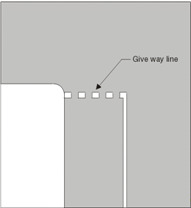
Example 2
Giving way at a give way sign to vehicles on the left and right
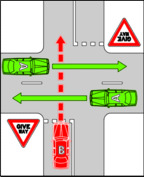
In this example, vehicle B must give way to each vehicle A.
Example 3
Giving way at a give way sign to an oncoming vehicle at a give way sign
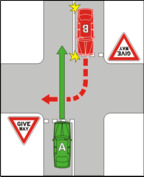
In this example, vehicle B must give way to vehicle A .
Example 4
Giving way at a give way sign to an oncoming vehicle that is not at a stop sign or give way sign
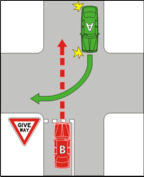
In this example, vehicle B must give way to vehicle A .
Example 5
Driver turning right at a give way line does not have to give way to a vehicle turning left using a slip lane
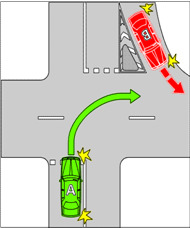
In this example, vehicle B must give way to vehicle A.